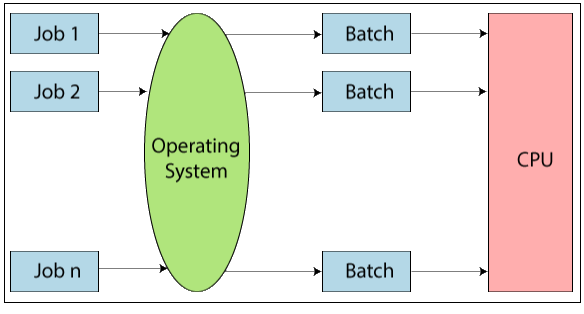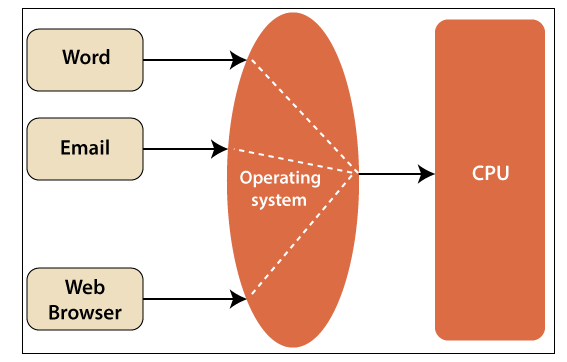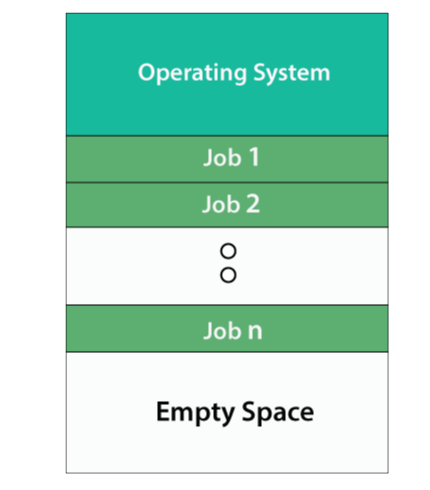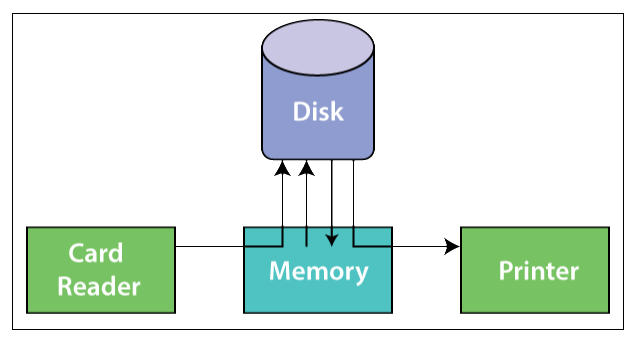Operating System Properties
The Properties of Operating System are:
- Batch processing
- Multitasking
- Multi-programming
- Interactivity
- Real-Time System
- Distributed Environment
- spooling
1. Batch Processing
In Batch Processing, the OS first gathers the data and programs together in a batch, then processing starts.
The operating system performs various types of activities related to batch processing:
- In this, the operating system defines the set of jobs that are re-assigned to a command sequence, data, and programs within a single unit.
- The operating system keeps the list of jobs in the memory then executes it one by one according to the scheduling algorithm.
- In this, the job is processed based on FCFS scheduling means first-come, first-serve.

Advantage of Batch Processing
The performance is increased because a new job is started early when the old job gets completed without any manual interference.
Disadvantages of Batch Processing
- Sometimes jobs are entered in an infinite loop.
- Debugging the program is tough.
2. Multitasking
Multitasking is a technique in which the CPU executes a number of jobs within the same time by switching among the jobs. The task of switching the job is so frequent that the user will be able to communicate with each program when the program is running.
The operating system performs the following activities in the context of multitasking.
- In this, the user directly instructs the OS or the program, and then obtain a fast response.
- The Operating system manages multitasking in such a way so that multiple operations can be handled at the same time.
- It is also known as a time-sharing system.
- Multitasking operating systems are developed so that we can use the computer system interactively at a less price.

3. Multi-programming
Multi-programming is defined as sharing of the processor when two or more programs exist in the memory at a time. With the help of multi-programming, the CPU utilization efficiency can be increased. In other words, Multi-programming is defined as the capability of an Operating system to run more than one program on a single processor. Example of Multi-programming: A computer can run excel and firebox browser simultaneously.

Advantages of Multi-programming
- Efficient CPU utilization.
- The users assume that CPU is simultaneously working on multiple programs.
Disadvantages of Multi-programming
- It needs CPU scheduling.
- Memory management is needed to accommodate different jobs in memory.
4. Interactivity
Interactivity means the user’s ability to interact with a computer system.
The operating system performs various activities related to interactivity.
- Handling input devices in order to take the input from the user. Example: - keyboard.
- It also helps to handle output devices to display output to the user. Example: - Monitor.
- It provides an interface to the user, so that the user can interact with the system.
5. Real-Time System
We can understand the Real-time system as the dedicated embedded systems,
An operating system performs various tasks related to a real-time system.
- In a real-time system, the operating system reads and reacts with the help of sensor data.
- The Operating system provides the assurance that the event is completed within a fixed interval of time to provide accurate performance.
6. Distributed Environment
A Distributed environment defines a set of multiple independent processors or CPUs in a single computer system.
The Operating system performs various activities, such as:
- The Operating system handles the communications between processors, and communication is done with the help of communication lines.
- Operating system share computation logic's among different physical processors.
- The processors will not share the memory; rather, each processor has its own local memory.
7. Spooling
Spooling stands for Simultaneous peripheral operation online. Spooling is a process in which jobs are put into a buffer, disk, or a particular area in the memory so that a device can access these jobs when it is ready.
Spooling is effective because, with the help of spooling devices can access the data with different rates. Buffer offers a waiting station so that data can respite at the time when the slower device catches up. The application of spooling is Print Spooling.
The operating system performs various tasks related to spooling:
- It manages the I/O device data spooling when devices have multiple data access rates.
- Handles parallel computation because the process of spooling is done I/O in a parallel way.
- Handles the spooling buffer that provides the waiting station for the data to take rest in that time when the slower device catches up.

Advantages of Spooling
- Spooling can overlap the I/O operation for one process with processor operations for another process.
- It uses disk as a huge buffer for the spooling operations.